Why gardening with kids is worth the mess
Gardening can help kids grow life skills as well as fruit and flowers. Check out these easy ideas to get them involved...
“Kids who get involved in gardening gain confidence,” says urban farmer Natasha Nicholes, who has been gardening with kids for years in the city of Chicago, USA. “They gain an appreciation for slowing down and enjoying life as it comes, instead of rushing the process.”
Nicholes started the We Sow We Grow Project in 2016 with her husband, to teach gardening skills to neighbourhood families. The kids she works with are focused on fun – so much so that they don’t realise they’re taking on life skills, too.
Green goodness
Studies have shown that early exposure to nature can lead to better mental health as adults. And ‘nature’ can include a garden.
“Whether it’s on the windowsill, at home, around your building or at school, the garden is an opportunity to nurture good mental health in our kids,” says Cam Collyer, senior advisor at Evergreen, an organisation facilitating sustainable change across Canada.
But besides improving mental health, gardening can teach kids social and executive function skills – everything from patience to perseverance to understanding different perspectives.
The key is to make kids active gardeners. “Kids are really drawn to a garden if it’s set up properly and they’re given the right invitation – not to watch, but really to participate,” Collyer says. They need to see gardening as something they can do, rather than a parental activity to observe.
Inspire your young gardeners to get and out about outside, with a subscription to National Geographic Kids magazine. Every issue features top tips for looking after our planet, alongside exciting articles, family-friendly crafts, educational games and more.
While some of the lessons from gardening are obvious – watering a plant every day teaches responsibility, for example – others might be less so. You can even couple the activity with some fun garden science experiments to tie in what they’re learning at school.
Here are a few unexpected life skills your children might learn from gardening; plus ways to keep them excited about digging in the dirt…
What skills does gardening grow in kids?
Curiosity
Collyer says when kids are set free in a garden, curiosity follows. And that leads them to ask important questions: “How does this work? What makes up the soil? How does the plant grow? Why are there different seeds of different shapes?”
And though the answers might help them learn about science, Collyer says the bigger gain here is the self-directed motivation for learning.
“When an action is compelling, ongoing and changing, the motivation for learning goes up,” he says. So, encourage your kids to ask questions and work independently (or with a little help) to find the answers.
Focus
Classrooms often require kids to focus intensely, but when they’re in natural settings like a garden, that focus changes and relaxes.
“There’s this very comfortable, soft focus that happens when you’re in a natural setting,” Collyer says.
That, he says, allows kids to better focus when they return to tasks like reading or maths, adding that it’s why forest bathing and outdoor classrooms have grown in popularity.
Appreciation
Gardeners love to throw around the saying, ‘Kids who grow their vegetables, eat their vegetables.’ And Collyer says it’s true – harvesting the garden teaches kids to appreciate the cycles that come from hard work and help them better appreciate the tasty results.
Parents can add to the appreciation by encouraging kids to think about how plants affect other things, whether it’s providing a share for humans or snacks for insects.
“A garden is not just about plants,” says Jennifer Reynolds, editor-in-chief at Harrowsmith magazine. “It’s about all the living creatures that come in and out of it, too.” Creating a compost can also help support these garden residents – and teach kids more about gardening.
Decision making and problem solving
Collyer says that, when gardening with kids, the children should be doing as much of the planting, watering and harvesting as they can, with adults along for guidance and supervision.
“That sense of ownership is really important,” he says. “This is where the process can be more important than the product.”
Feeling empowered by tending a garden gives kids the confidence to make their own decisions and solve problems. For instance, when caterpillars threatened the tomatoes in Nicholes’ garden, it was the local kid-gardeners who came up with a plan.
“Instead of pulling the caterpillars off and dropping them in soapy water, they figured we could make our chickens happy by providing them with a treat,” she recalls.
Patience and resilience
Sometimes the garden doesn’t grow. Or a plant is mistaken for a weed and pulled by accident. Dealing with disappointment and finding the resolve to try again are important lessons, too, Nicholes says. “It’s what creates well-rounded folks.”
Gardening with kids
Do you have a reluctant gardener, or just want to get kids excited for the task? Try one of these techniques…
Set a recurring time
Make sure everyone knows when it’s time to play in the garden by setting a specific time each week. And make sure devices – theirs and yours – aren’t invited. “When parents do this together with kids, it sticks and is way more fun,” Reynolds says.
Bring a blindfold
A scarf or necktie tied loosely around a child’s eyes can transform the garden from a bunch of green leaves into a sensory experience. “Blindfolds open up other senses,” Collyer says. Smell the flowers, touch the furry leaves (steer clear of prickles!) and feel the different shapes of stems.
Plan a scavenger hunt
Reynolds suggests writing garden treasures on a recyclable paper bag, then using the bag to collect the goodies. Some ideas:
- – One leaf from a stalk with no flowers
- – Another leaf from a stalk with a bloom
- – Dirt from beside the tallest plant in the garden
- – Seeds from three different plants
- – An ‘ugly’ fruit or vegetable that will still taste delicious
Use nature’s crayons
All those green leaves might be hiding a colourful surprise. Collyer often takes kids into the garden with white paper in hand for an art project he calls ‘Nature’s Palette’.
Start by having the kids collect different leaves, a bit of soil, soft rocks and bark from the garden. “And then you simply start rubbing whatever you’ve got into this canvas,” he says. “There’s inevitably a surprise.”
Create a space
Instead of just gardening with kids, offer children a space that’s all their own. Nicholes suggests letting them design the area (maybe decorating with things from around the garden or house) and choose the seeds or flowers they plant.
No room in your garden – or no garden at all? No problem. “Let them design a raised bed or container garden to see how things work together,” she says.
Visit other gardens
Exposing kids to different gardens can make them more aware of the way their community’s landscape works together. Take trips out to planned parks, public gardens, private gardens (with permission) and other places to observe how people are playing with plants. You could even take part in a community gardening project like tree-planting!
“It makes the idea of gardening more holistic,” Reynolds says. “Raising good nature lovers and good observers is what makes good gardeners – they notice what’s around them and build on it.”




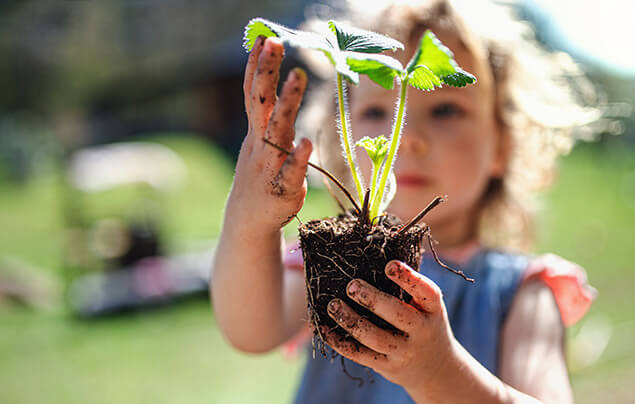

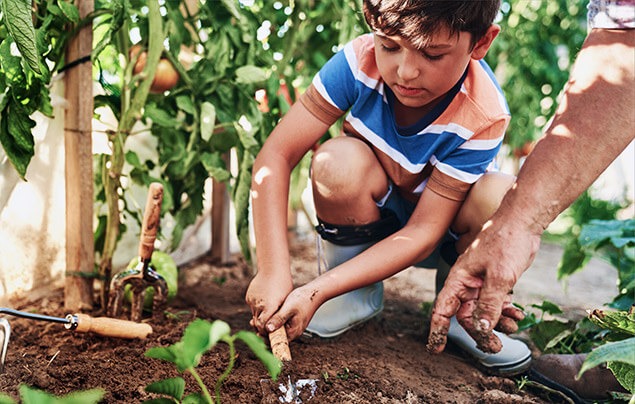
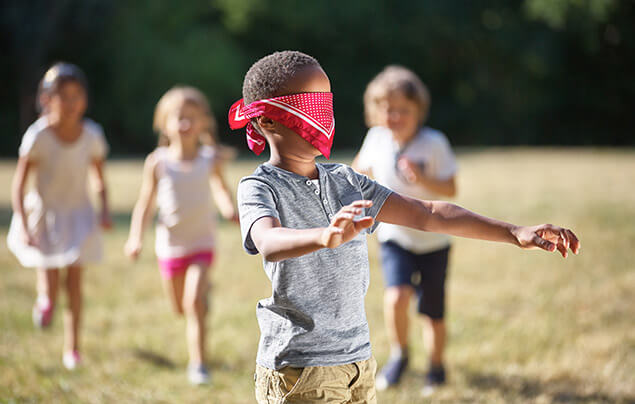
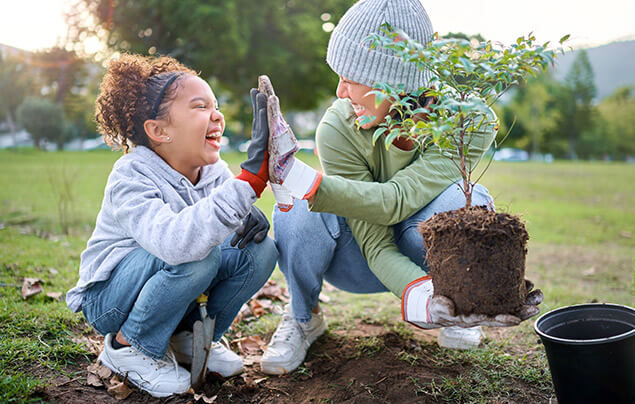




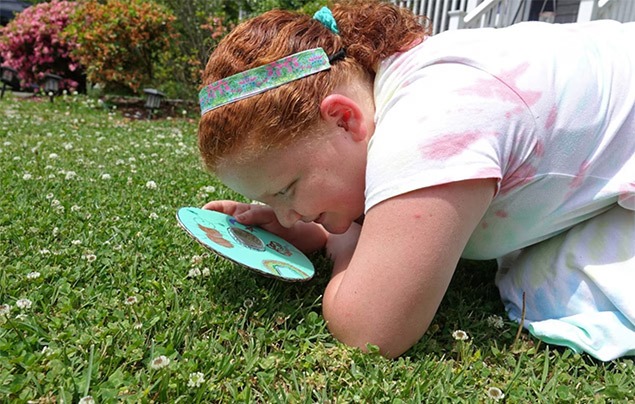




LEAVE A COMMENT
THANK YOU
Your comment will be checked and approved shortly.
WELL DONE,
YOUR COMMENT
HAS BEEN ADDED!
COMMENTS
CUSTOMIZE YOUR AVATAR